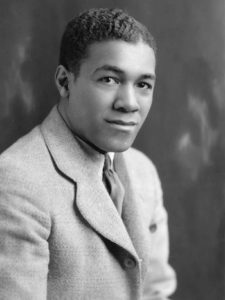
Lawrence Knox
*Lawrence Knox was born on this date in 1906. He was a Black Chemist and teacher. Lawrence Howland Knox was born in New Bedford, Massachusetts, the son of William Knox.
He had four siblings, two sisters and two brothers. In the 1820s, his grandfather, Elijah Knox, was born in North Carolina to a slave family. Through hard work and determination, he became an expert carpenter and gained freedom in 1846. He traveled north and settled in New Bedford, Massachusetts. Elijah's son -William Jacob- established an important precedent for future generations of upward mobility through education. William received the highest score on the New Bedford civil service exam in 1903 and then acquired a position at the post office in 1905. He eventually married his wife, Estella.
1928 Knox received a Bachelor of Science degree in chemistry at Bates College. Throughout his attendance at Bates College, he participated in numerous extracurricular functions, a member of the Jordan Scientific Society, and lettered football as a right halfback. He experienced little discrimination during his attendance at Bates College. In 1930, Lawrence started at Stanford University, and after one year, he received a Master of Science degree.
Knox continued his education at Harvard University and received his Doctorate in organic chemistry in 1940. His dissertation was titled "[Bicyclic structures prohibiting the Walden inversion. Replacement reactions in 1-substituted 1-apocamphanes]". He was among the first Blacks to receive a Ph.D. in chemistry, following his eldest brother William Jacob Knox. He worked with Paul Doughty Bartlett on an experiment for testing organic mechanisms in chemistry, which involved the use of the molecule bicyclo (2.2.1) heptane, a type of bicyclic molecule. Additionally, Lawrence made significant contributions, such as publishing papers about aromatic hydrocarbon molecules and proving Erick Hickel’s’ theory about aromatic hydrocarbons correct.
Between degrees, he taught at Morehouse College. Knox was head of the chemistry department at North Carolina College (formerly called the North Carolina College for Negros) and taught at North Carolina Agricultural and Technical State University. In 1944, Knox worked for the Division of War Research at Columbia University, where he studied radiation. His work was utilized in research for the Manhattan Project regarding the effects of atomic bombs while helping the Division of War Research develop the malaria drug quinine. Knox is credited with at least two U.S. Patents, the Production of Arecoline accepted on May 2nd, 1950, and the Photochemical Preparation of Tropilidenes in 1953.
His quinine research was used to study the effects of atomic bomb explosions. After the war, Knox earned four patents in three years of working at Nopco Chemists. He became the resident director at the Hickrill Chemical Research Foundation and eventually moved to Mexico City to work at Laboratorios Syntex S.A. Lawrence Knox died of carbon monoxide poisoning on January 6, 1966, at Colegio Vista Hermosa, Mexico City.